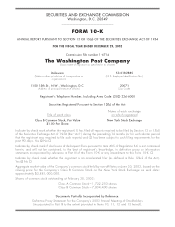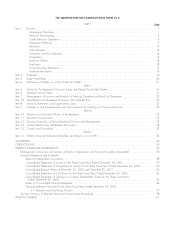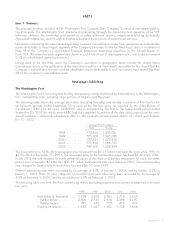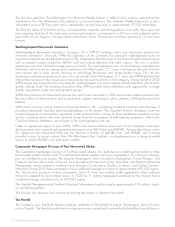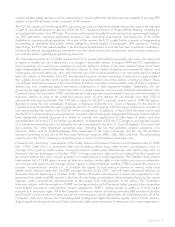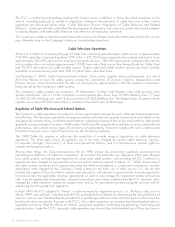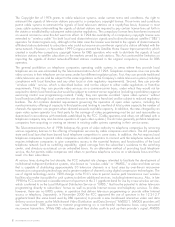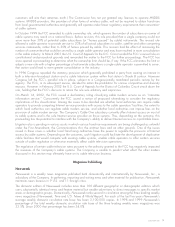Washington Post 2002 Annual Report Download - page 8
Download and view the complete annual report
Please find page 8 of the 2002 Washington Post annual report below. You can navigate through the pages in the report by either clicking on the pages listed below, or by using the keyword search tool below to find specific information within the annual report.The FCC is conducting proceedings dealing with various issues in addition to those described elsewhere in this
section, including proposals to modify its regulations relating to the operation of cable television systems (which
regulations are discussed below under ‘‘Cable Television Division – Regulation of Cable Television and Related
Matters’’), and proposals that could affect the development of alternative video delivery systems that would compete
in varying degrees with both cable television and television broadcasting operations.
The Company is unable to determine what impact the various rule changes and other matters described in this section
may ultimately have on the Company’s television broadcasting operations.
Cable Television Operations
At the end of 2002 the Company (through its Cable One subsidiary) provided basic cable service to approximately
718,000 subscribers (representing about 57% of the 1,255,000 homes passed by the systems) and had in force
approximately 340,000 subscriptions to premium program services, 196,000 subscriptions to digital video service
(which number does not include approximately 19,000 free trials of that service then being offered by Cable One)
and 78,000 subscriptions to cable modem service. Digital video and cable modem services are each currently
available in markets serving more than 93% of Cable One’s subscriber base.
On November 1, 2002, Cable One transferred its Akron, Ohio system, together with a cash payment, to a unit of
AOL Time Warner in return for cable systems serving the communities of Chanute, Emporia, Independence and
Parsons, Kansas. That transaction had the effect of increasing by approximately 5,000 the number of subscribers
being served by the Company’s cable systems.
The Company’s cable systems are located in 19 Midwestern, Southern and Western states and typically serve
smaller communities: thus 21 of the Company’s current systems pass fewer than 10,000 dwelling units, 17 pass
10,000-25,000 dwelling units, and 18 pass more than 25,000 dwelling units. The largest cluster of systems (which
together serve about 89,000 subscribers) is located on the Gulf Coast of Mississippi.
Regulation of Cable Television and Related Matters
The Company’s cable operations are subject to various requirements imposed by local, state and federal governmen-
tal authorities. The franchises granted by local governmental authorities are typically nonexclusive and limited in time
and generally contain various conditions and limitations relating to payment of fees to the local authority, determined
generally as a percentage of revenues. Additionally, franchises often regulate the conditions of service and technical
performance, and contain various types of restrictions on transferability. Failure to comply with such conditions and
limitations may give rise to rights of termination by the franchising authority.
The 1992 Cable Act requires or authorizes the imposition of a wide range of regulations on cable television
operations. The three major areas of regulation are (i) the rates charged for certain cable television services,
(ii) required carriage (‘‘must carry’’) of some local broadcast stations, and (iii) retransmission consent rights for
commercial broadcast stations.
Among other things, the Telecommunications Act of 1996 altered the preexisting regulatory environment by
expanding the definition of ‘‘effective competition’’ (a condition that precludes any regulation of the rates charged
by a cable system), terminating rate regulation for some small cable systems, and sunsetting the FCC’s authority to
regulate the rates charged for optional tiers of service (which authority expired on March 31, 1999). Since none of
the cable systems owned by the Company falls within the effective-competition or small-system exemptions, monthly
subscription rates charged by the Company’s cable systems for the basic tier of cable service (i.e., the tier that
includes the signals of local over-the-air stations and any public, educational or governmental channels required to
be carried under the applicable franchise agreement), as well as rates charged for equipment rentals and service
calls, may be regulated by municipalities, subject to procedures and criteria established by the FCC. However, rates
charged by cable television systems for pay-per-view service, for per-channel premium program services and for
advertising are all exempt from regulation.
In April 1993 the FCC adopted a ‘‘freeze’’ on rate increases for regulated services (i.e., the basic and, prior to
March 1999, optional tiers). Later that year the FCC promulgated benchmarks for determining the reasonableness of
rates for such services. The benchmarks provided for a percentage reduction in the rates that were in effect when the
benchmarks were announced. Pursuant to the FCC’s rules, cable operators can increase their benchmarked rates for
regulated services to offset the effects of inflation, equipment upgrades, and higher programming, franchising and
regulatory fees. Under the FCC’s approach cable operators may exceed their benchmarked rates if they can show in
6THE WASHINGTON POST COMPANY

